新概念英语第二册语法知识点:倒装句
新概念英语第二册特殊句型讲解
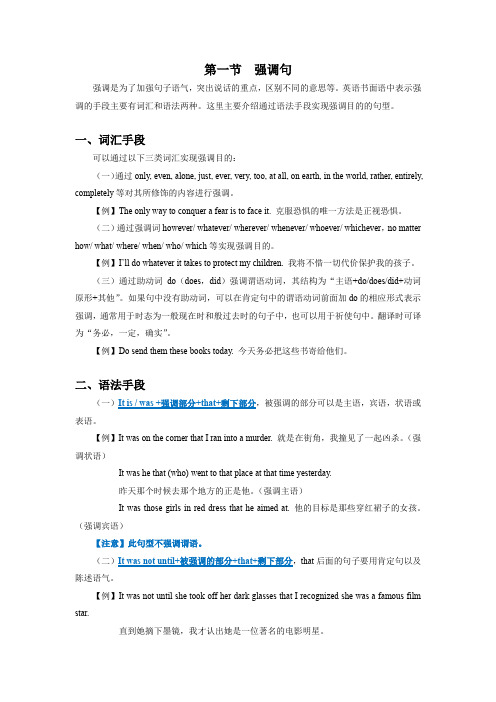
第一节强调句强调是为了加强句子语气,突出说话的重点,区别不同的意思等。
英语书面语中表示强调的手段主要有词汇和语法两种。
这里主要介绍通过语法手段实现强调目的的句型。
一、词汇手段可以通过以下三类词汇实现强调目的:(一)通过only, even, alone, just, ever, very, too, at all, on earth, in the world, rather, entirely, completely等对其所修饰的内容进行强调。
【例】The only way to conquer a fear is to face it. 克服恐惧的唯一方法是正视恐惧。
(二)通过强调词however/ whatever/ wherever/ whenever/ whoever/ whichever,no matter how/ what/ where/ when/ who/ which等实现强调目的。
【例】I’ll do whatever it takes to protect my children. 我将不惜一切代价保护我的孩子。
(三)通过助动词do(does,did)强调谓语动词,其结构为“主语+do/does/did+动词原形+其他”。
如果句中没有助动词,可以在肯定句中的谓语动词前面加do的相应形式表示强调,通常用于时态为一般现在时和般过去时的句子中,也可以用于祈使句中。
翻译时可译为“务必,一定,确实”。
【例】Do send them these books today. 今天务必把这些书寄给他们。
二、语法手段(一)It is / was +强调部分+that+剩下部分,被强调的部分可以是主语,宾语,状语或表语。
【例】It was on the corner that I ran into a murder. 就是在街角,我撞见了一起凶杀。
(强调状语)It was he that (who) went to that place at that time yesterday.昨天那个时候去那个地方的正是他。
新概念英语第二册倒装结构课件
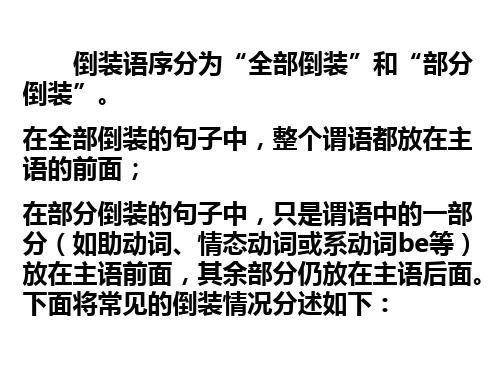
No sooner had he arrived there than he fell ill. 注:上面所说的词和词组如果不在句首,句子不必用倒装语序。另 外,not only…but also连接两个主语时,不用倒装,如: Not only the students, but also the teacher wishes for a holiday.
8.Now____ Sally’s turn to keep guard.
9.Not only_____ polluted but_____ crowded. A.was the city; were the streets B.the city was; were the streets C.was the city; the streets were D.the city was; the streets were
10.So___ that no fish can live in it.
A.the lake is shallow B.shallow the lake is
C.shallow is the lake D.is the lake shallow
11.Little_____ about his own safety, though he
倒装语序分为“全部倒装”和“部分 倒装”。
在全部倒装的句子中,整个谓语都放在主 语的前面;
在部分倒装的句子中,只是谓语中的一部 分(如助动词、情态动词或系动词be等) 放在主语前面,其余部分仍放在主语后面。 下面将常见的倒装情况分述如下:
《新概念英语第二册》语法总结

《新概念英语第二册》语法总结一、冠词The Article知识要点:冠词是一种虚词,放在名词的前面,帮助说明名词的含义。
冠词分不定冠词(The Indefinite Article)和定冠词(The definite Article)两种。
a (an) 是不定冠词,a用在辅音之前:如a book, a man; an用在元音之前,如:an old man, an hour, an interesting book等。
the是定冠词。
一、不定冠词的用法1、指人或事物的某一种类(泛指)。
这是不定冠词a (an)的基本用法。
如:She is a girl. I am a teacher. Please pass me an apple.2、指某人或某物,但不具体说明何人或何物。
如:He borrowed a story-book from the library.A Wang is looking for you. 一位姓王的同志正在找你。
3、表示数量,有“一”的意思,但数的概念没有one强烈。
如:I have a mouth, a nose and two eyes.4、用于某些固定词组中。
如:a bit, a few, a little, a lot of, a piece of, a cup of, a glass of, a pile of, a pair of, have a good time, for a while, for a long time等。
5、用在抽象名词前,表具体的介绍——a + 抽象名词,起具体化的作用。
如:This little girl is a joy to her parents. 这女孩对她父母来说是一个乐趣。
It is a pleasure to talk with you. 跟您交谈真是一件愉快的事情。
It is an honour to me to attend the meeting. 参加这个会,对我来说是一种荣誉。
新概念英语第二册倒装句
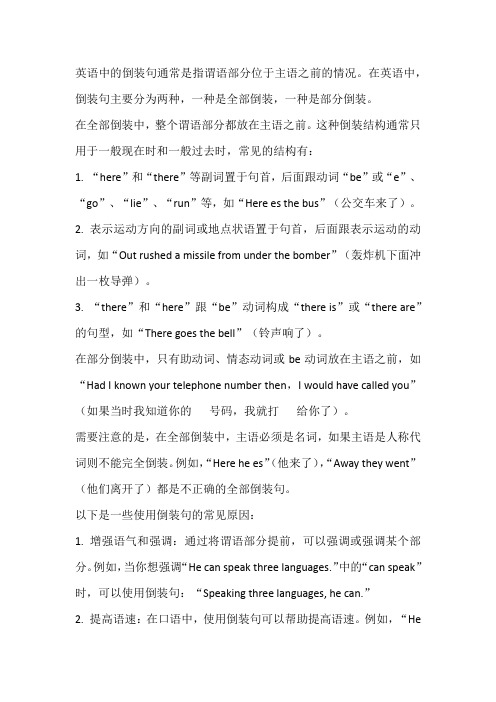
英语中的倒装句通常是指谓语部分位于主语之前的情况。
在英语中,倒装句主要分为两种,一种是全部倒装,一种是部分倒装。
在全部倒装中,整个谓语部分都放在主语之前。
这种倒装结构通常只用于一般现在时和一般过去时,常见的结构有:1. “here”和“there”等副词置于句首,后面跟动词“be”或“e”、“go”、“lie”、“run”等,如“Here es the bus”(公交车来了)。
2. 表示运动方向的副词或地点状语置于句首,后面跟表示运动的动词,如“Out rushed a missile from under the bomber”(轰炸机下面冲出一枚导弹)。
3. “there”和“here”跟“be”动词构成“there is”或“there are”的句型,如“There goes the bell”(铃声响了)。
在部分倒装中,只有助动词、情态动词或be动词放在主语之前,如“Had I known your telephone number then,I would have called you”(如果当时我知道你的号码,我就打给你了)。
需要注意的是,在全部倒装中,主语必须是名词,如果主语是人称代词则不能完全倒装。
例如,“Here he es”(他来了),“Away they went”(他们离开了)都是不正确的全部倒装句。
以下是一些使用倒装句的常见原因:1. 增强语气和强调:通过将谓语部分提前,可以强调或强调某个部分。
例如,当你想强调“He can speak three languages.”中的“can speak”时,可以使用倒装句:“Speaking three languages, he can.”2. 提高语速:在口语中,使用倒装句可以帮助提高语速。
例如,“Hewill fly to New York.”可以说成“Will he fly to New York?”3. 引入背景信息:使用倒装句可以帮助引出背景信息,从而使读者更容易理解句子的内容。
新概念英语第二册语法知识点汇总

新概念英语第二册语法知识点汇总本文档将对《新概念英语第二册》中的语法知识点进行汇总。
以下是该册教材中的重要语法知识点:1. 时态- 现在完成时:表示过去发生的事情对现在产生的影响,构成为"have/has + 过去分词"。
- 过去完成时:表示过去某个时间或事件之前发生的动作或状态,构成为"had + 过去分词"。
- 将来进行时:表示将来某个时间正在进行的动作,构成为"will be + 动词-ing"。
2. 句型- There be句型:表示某处存在某物或某人,构成为"There + be 动词 + 宾语"。
- 虚拟语气:表示与事实相反的假设、愿望或建议的语气,构成为"if + 主语 + 过去式,主语 + would/could/might + 动词原形"。
3. 名词- 可数名词与不可数名词:可数名词可以同时使用单复数形式,而不可数名词只能使用单数形式。
- 复合名词:由两个或更多个词构成的名词,如"homework"、"football"等。
4. 冠词- 定冠词:表示特指的冠词,如"the"。
- 不定冠词:表示泛指的冠词,如"a/an"。
5. 代词- 主格代词:在句子中作主语,如"I"、"you"等。
- 宾格代词:在句子中作宾语,如"me"、"you"等。
- 物主代词:表示所属关系的代词,如"my"、"your"等。
6. 动词- 不定式:表示动作的动词原形,可以作主语、宾语等,如"to eat"。
- 动词的时态变化:根据不同的时态,在动词前加不同的助动词,如"is/am/are"表示现在进行时。
新概念英语第二册强调句和倒装句课件
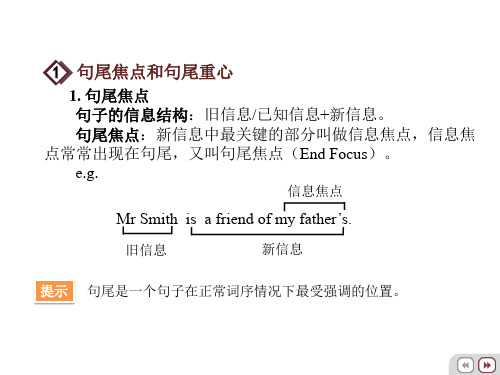
提示 交际中根据特定的语义意图,调用语法手段,将关键信息置于句 尾,以突出该信息。
2. 句尾焦点和句尾重心原则的若干应用 (1)It充当形式主语或形式宾语 e.g. It’s necessary for every student to observe school regulations.
提示1 than,as引导的状语分句一般为正常语序,但在正式语体中,特 别是科技英语中,也可以用倒装。
提示2 当状语从句的主语是人称代词时,则不用倒装。如:We now know a lot more about the universe than we did ten years ago.
1 不引起倒装的前置
2 引起倒装的前置
全部倒装:整个谓语动词置于主语之前。 局部倒装:只是操作词置于主语之前。
1. 状语前置引起倒装现象
(1)句首状语为方位词或拟声词,谓语动词是come,go等 表示位置移动的动态动词时,通常用全部倒装。
e.g. The door burst open and in rushed the crowd. There was a sudden gust of wind and away went his hat. Bang! bang! bang! came three reports of firecrackers and Philip suddenly felt his body become light.
hour, was expertly handled. —The cross-examination, lasting only half an hour,
was expertly handled. —The half-hour cross-examination was expertly
新概念英语第二册语法练习:倒装句

新概念英语第二册语法练习:倒装句一、倒装的类型1.完全倒装:整个谓语移至主语之前。
Out rushed the students to welcome the foreign friends.2.部分倒装:只把系动词,情态动词,助动词或表语放在主语之前。
Seldom does he go to school late.二、倒装结构的基本用法1、因为语法结构的需要而使用的倒装1) 疑问句中,用完全或部分倒装,但以疑问词或疑问词修饰的名词作主语的疑问句要用正常语序Where did he go last Monday?Are you listening to the radio?2) “there be”结构中,There are three wells in our village.There stands a big paper making factory by the river.3) 在以here, there, now, then, in, away, up down等副词开头的句子中,使用完全倒装结构。
但如果主语是代词则用正常语序。
There goes the bell.Now comes your turn to playDown she went.4) 在以neither nor 或no more开头的句子中,表示“……也不这样”, neither和nor意思相同,能够替换使用;no more表示动作的水准并不比前面提到的稍强,意为“也不……”。
I can’t swim, nor (neither) can s he .He hasn’t been to the countryside, neither does he want to go there.He did not turn up. No more did his wife.5) 用在as(即使)引导的让步状语从句中,从属连句as用于特殊语序,含义与though, although相同,但“as”这种结构可表示非常强烈的对照,必须用倒装(表语提前)。
《新概念英语第二册》语法精粹(含习题):倒装句

《新概念英语第二册》语法精粹英语的基本句型是主语+ 谓语。
如果将主语与谓语调换, 称倒装句。
倒装句分全倒装句和半倒装句。
一、全倒装: 主语与谓语交换位置不需任何助动词, 叫全倒装。
全倒装有以下三种情况:1、当here, there, out, in, up, down等副词放在句首时, 句子需全倒装:There goes the bell! 铃响了!There lived an old man. Here comes the bus.注意:①在这种情况下倒装仅限于不及物动词或be动词, 像go, come, mush等。
②主语如果是代词时不需倒装如Away he went. 他走远了。
2、方位状语在句首, 如:In front of the house stopped a police car.Nearby were two cano es in which they had come to the island.Under the tree sat a boy.3 、直接引语在句首, 这种情况可倒装也可不倒装"What does it mean?" asked the boy或the boy asked.二、半倒装: 主语与谓语的助动词交换位置称半倒装, 有以下数种情况:1. 否定意义的词在句首, 句子半倒装, 例如: little, never, not, no, hardly, rarely, seldomNever shall I forget you.At no time was the man aware of what was happening.Little did I understand what he said to me at that time.2.几对并列连词如not only…but also, hardly… when等连接两个并列句, 连词在句首, 前句半倒装, 后句不倒装:Not only was everything he had taker away from him, but also his German citizenship was taken away.No sooner had I got to the bus stop than the bus started.(注意时态)注意:①not only…but also连接两个并列主语时不需倒装, 如:Not only you but also I like playing chess.②neither…nor在句首时, 前后两句都需倒装,Neither do I have a sister nor does my husband.3、only在句首强调状语, 主句半倒装:Only then did I realize that I was wrong.Only in this way can I learn from my fault.Only when the war was over in 1918, was he able to get back to work.注意: only强调主语不倒装:Only the teachers can use the room.4、so…that句型, so在句首时, 主句倒装, that从句不倒装:So easy is it that a clild can learn it.So hard did he work that he finally won the fame.I saw the film, so did he.1、倒装句(Inversion)英语的基本语序是“主语+谓语”。
新概念第二册 Lesson 36 Across the Channel (倒装句)
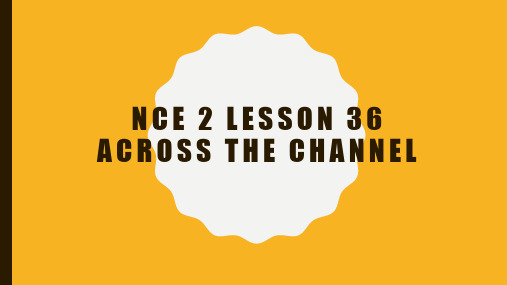
train /treɪn/ v. 训练 anxiouly /æŋkʃəsli/ adv. 焦急地 intend /ɪnˈtend/ v. 打算 solid /ˈsɒlɪd/ adj. 固体的,硬的
RECORD
record /'rekɔːrd/ n. & v. 记录 E.g. That athlete has broken the world record. 那位运动员打破了世界纪录。
完全倒装句:谓语全部置于主语之前。通常只用于一般现在时和一般过去时, 主语为 代词,不用倒装。如:The door opened and in she came. 门开了, 她走了进来。
1. 以 here,there,now,then,out,in,up,down,off,away 等方向副词开头的 句子,且句子主语是名词时, 为了表达生动, 用完全倒装, 如: Here comes the bus.公 共汽车来了。 2. 将表语和地点状语(多为介词短语)置于句首加以强调时,其后通常用倒装语序。 如: Among them will be Debbie's mother, who swam the Channel herself when she was a girl. 他们当中还会有黛比的母亲,她本人还是个姑娘时,也曾横渡过英吉利海峡!
a small boat. Mr. Hart has trained his daughter for years. is sure to succeed. 许多
Tomorrow he will be distance to England.
watching her anxiously as she swims the long Debbie intends to take short rests every two
33-36课新概念英语第二册知识点
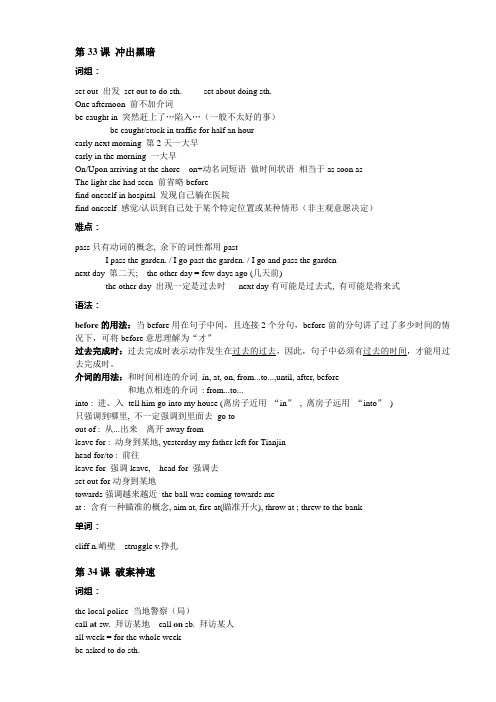
第33课冲出黑暗词组:set out 出发set out to do sth. set about doing sth.One afternoon 前不加介词be caught in 突然赶上了…陷入…(一般不太好的事)be caught/stuck in traffic for half an hourearly next morning 第2天一大早early in the morning 一大早On/Upon arriving at the shore on+动名词短语做时间状语相当于as soon asThe light she had seen 前省略beforefind oneself in hospital 发现自己躺在医院find oneself 感觉/认识到自己处于某个特定位置或某种情形(非主观意愿决定)难点:pass只有动词的概念, 余下的词性都用pastI pass the garden. / I go past the garden. / I go and pass the gardennext day 第二天; the other day = few days ago (几天前)the other day 出现一定是过去时next day有可能是过去式, 有可能是将来式语法:before的用法:当before用在句子中间,且连接2个分句,before前的分句讲了过了多少时间的情况下,可将before意思理解为“才”过去完成时:过去完成时表示动作发生在过去的过去,因此,句子中必须有过去的时间,才能用过去完成时。
介词的用法:和时间相连的介词in, at, on, from...to...,until, after, before和地点相连的介词: from...to...into : 进、入tell him go into my house (离房子近用“in”, 离房子远用“into”)只强调到哪里, 不一定强调到里面去go toout of : 从...出来离开away fromleave for : 动身到某地, yesterday my father left for Tianjinhead for/to : 前往leave for 强调leave, head for 强调去set out for动身到某地towards强调越来越近the ball was coming towards meat : 含有一种瞄准的概念, aim at, fire at(瞄准开火), throw at ; threw to the bank单词:cliff n.峭壁struggle v.挣扎第34课破案神速词组:the local police 当地警察(局)call at sw. 拜访某地call on sb. 拜访某人all week = for the whole weekbe asked to do sth.be wanted 被通缉not….anymore = no morepick up 意外地找到;逐步回升go to the pictures 去看电影难点:call on拜访call (sb.) up给某人打电话call off 取消/ call out 大声喊/ call at 去了某地+地点/ call in 召集语法:被动语态:1.一般时态的被动语态:1)一般现在时的被动语态——be done2)一般过去时的被动语态——was/were done3)一般将来时的被动语态——will/shall be done4)一般过去将来时的被动语态——would be done2. 进行时态的被动语态:1)现在进行时的被动语态——am/are/is being done2)过去进行时的被动语态——was/were being done3. 完成时态的被动语态:1)现在完成时的被动语态——has/have been done2)过去完成时的被动语态——had been done4. 情态动词的被动结构:She might be sent to work abroad.5.不定式结构的被动形式:This book is to be published next year.注意:只有及物动词和动词短语,即能带宾语的,才有被动语态。
新概念英语中倒装句、感叹句的用法

1. 感叹句:1)What +名词+主语+谓语What a beautiful girl she is!2)How + 形容词+主语+谓语How beautiful the girl is!2. 倒装句:so/neither的倒装He can swim. So can I.I didn’t go to class. Neither did I.结构:so/neither+be+ 主语///so/neither+助动词+主语///so/neither+情态动词+ 主语一般现在时,do, does/am, is, are现在进行时,am, is, are一般过去时,did现在完成时,have, has一般将来时,will, shall,过去进行时,was, were过去完成时,had过去将来时,would3 直接引语/间接引语1)定义:直接引语是指原封不动的引用原话,把它放在引号内,例如:They said, “We want to have a rest.”间接引语即用自己的话加以转述,被转述的话不放在引号内。
上面的例句变成间接引语应该是:They said they wanted to have a rest.2)当我们把直接引语变成间接引语时,由于引述动词(said,told等)一般都是过去时形式,因此间接引语中的动词时态、人称代词、限定词、时间状语、地点状语等一般都要做相应的变化。
有下面几种情况:1)时态变化:一般现在时--一般过去时现在进行时--过去进行时一般过去时--过去完成时现在完成时--过去完成时一般将来时--过去将来时be going to--was/were going to/wouldcan--couldmay—might2)时间地点及指示词的变化:here-there, tomorrow-the next day, the following day, this-that…3)人称变化:根据句意改变人称。
新概念第二册语法总结

新概念英语二册语法总结1.简单句的结构:主语+谓语+宾语+状语(地点状语+方式状语+时间状语)时间状语还可以放在句首2.一般现在时,现在进行时感叹句:what+名词+主语+谓语,how+形容词/副词+主语+谓语频度副词:位于主语和谓语之间,常见频度副词及其程度的深浅:always, often, usually, frequently, sometimes, hardly, rarely, seldom, neverI always buy CDs on Sundays.3.一般过去时直接宾语和间接宾语:主语+及物动词+间接宾语+直接宾语直接宾语是及物动词的直接对象,间接宾语是及物动词的动作所涉及的人或事务,也可以说间接宾语表示动作是对谁做的,或者是为谁做的。
所以间接宾语要用名词或者宾格代词来担当。
He gives me a book.me间接宾语, a book直接宾语直接宾语和间接宾语的位置调换时要加一个介词to或for,to表示动作对谁而做,for表示动作为谁而做。
主语+及物动词+直接宾语+介词+间接宾语Give the book to me.Send a letter to him.I bought a coat for my mother.4.现在完成时,注意频度及时间副词的位置receive/take5.复习:一般过去时与现在完成时的区别in the way/on the way/in this way/by the way/in a way/get out of my way/Don’t stand in my way./by the way/no wayspare/to spare6.冠词用法(一)1.不定冠词用于修饰单数可数名词,当一个单词的第一个发音为元音时要用冠词an, 如果是辅音用a即可。
2.不定冠词还可以用来修饰一类事物,有时候也可以省略:A cat is a lovely animal. Cat is a lovely animal.3.不可数名词加冠词表示一类事物:Apple is a fruit.4.如果特制某人,某物或上文提过的人或物时要用定冠词the5.Some表示一些,可以修饰可数名词及不可数名词。
新概念英语第二册++倒装句++课件

1. 以here, there, now, then等副词或 out, in, up, down, away等表示运动方
向的副词或地点状语置于句首以示强调,
句子要全部倒装,谓语动词常用come,go, be, lie,run,rush等
铃响了。 公车来了。
There goes the bell.
5.用于so nor neither 开头的句子
此类倒装用于重复前句部分内容 前句是肯定句用SO 某人/某事也是 前句是否定句用neither nor某人/某事也不是
So +be/助动词/情态动词+主 语 某人也是如此 Nor/neither +be/助动词/情 态动词+主语 某人也不是如此
He has been to Beijing. So have I.
On top of the hill stands a
watchtower.
把be/助动词/情态动词 提前到主语 的前面
Is am are was were
do does did
can could would may will might 等
1.only所修饰的副词、介词短语或状语从句 放在句首时, 要进行部分倒装,如: Only then did I realize the importance of learning English. Only in this way can you hope to improve the situation there. Only after he came back was I able to see him. 注:only修饰主语,仍用自然语序,如:
Had he followed my advice, he would
最全的新概念英语第二册语法汇总
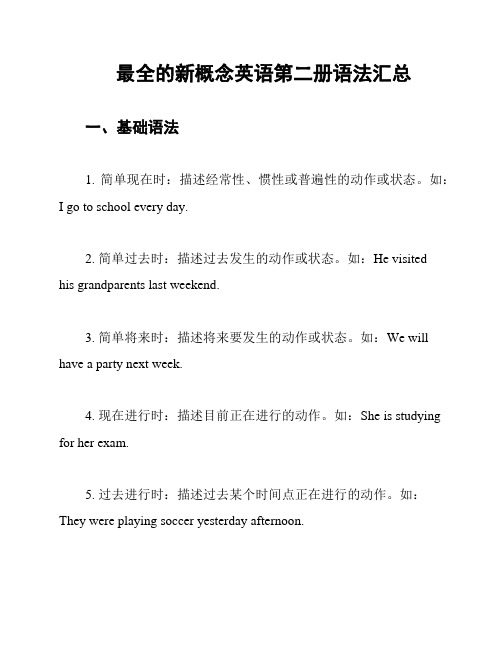
最全的新概念英语第二册语法汇总一、基础语法1. 简单现在时:描述经常性、惯性或普遍性的动作或状态。
如:I go to school every day.2. 简单过去时:描述过去发生的动作或状态。
如:He visitedhis grandparents last weekend.3. 简单将来时:描述将来要发生的动作或状态。
如:We will have a party next week.4. 现在进行时:描述目前正在进行的动作。
如:She is studying for her exam.5. 过去进行时:描述过去某个时间点正在进行的动作。
如:They were playing soccer yesterday afternoon.6. 将来进行时:描述将来某个时间将会进行的动作。
如:I will be working late tonight.二、进阶语法1. 被动语态:表示动作的承受者在句中更重要。
如:The book was written by him.2. 间接引语:重述别人说的话,常常使用动词say、tell等。
如:He said that he was tired.3. 定语从句:用来修饰名词,常以关系代词who、which、that引导。
如:The man who is talking to Mary is my uncle.4. 倒装句:将句子的主语和谓语动词的位置颠倒。
如:Only by working hard can you achieve success.5. 条件句:表示假设、条件或可能性,分为三种类型。
如:If I have time, I will go to the party.6. 反意疑问句:通常由一个肯定句和一个否定短语组成。
如:You like coffee, don't you?三、高级语法2. 主语从句:作为句子的主语,由连词that引导。
新概念英语第二册倒装句语法知识
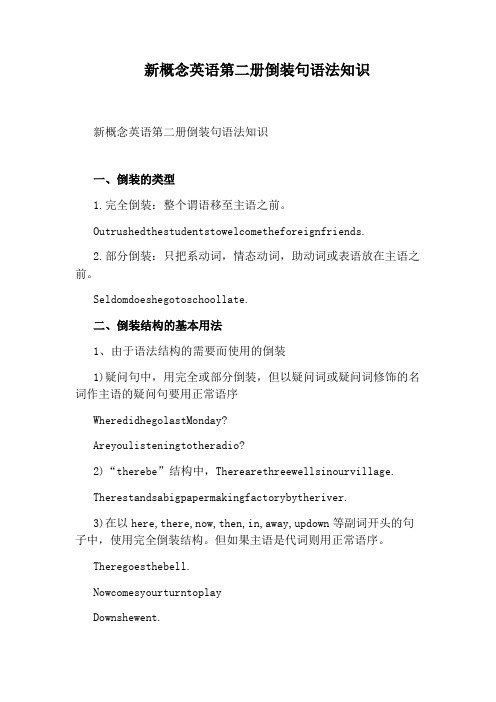
新概念英语第二册倒装句语法知识新概念英语第二册倒装句语法知识一、倒装的类型1.完全倒装:整个谓语移至主语之前。
Outrushedthestudentstowelcometheforeignfriends.2.部分倒装:只把系动词,情态动词,助动词或表语放在主语之前。
Seldomdoeshegotoschoollate.二、倒装结构的基本用法1、由于语法结构的需要而使用的倒装1)疑问句中,用完全或部分倒装,但以疑问词或疑问词修饰的名词作主语的疑问句要用正常语序WheredidhegolastMonday?Areyoulisteningtotheradio?2)“therebe”结构中,Therearethreewellsinourvillage.Therestandsabigpapermakingfactorybytheriver.3)在以here,there,now,then,in,away,updown等副词开头的句子中,使用完全倒装结构。
但如果主语是代词则用正常语序。
Theregoesthebell.NowcomesyourturntoplayDownshewent.4)在以neithernor或nomore开头的.句子中,表示“……也不这样”,neither和nor意思相同,可以替换使用;nomore表示动作的程度并不比前面提到的稍强,意为“也不……”。
Ican’tswim,nor(neither)canshe.Hehasn’tbeentothecountryside,neitherdoeshewanttogothere.Hedidnotturnup.Nomoredidhiswife.5)用在as(尽管)引导的让步状语从句中,从属连句as用于特殊语序,含义与though,although相同,但“as”这种结构可表示非常强烈的对照,必须用倒装(表语提前)。
Proudasthenoblesare,heisafraidtoseeme.Youngasheis,heknowsalot.2、为了加强语气而使用的倒装。
新概念L94 BOOK 2--倒装句经典讲解

Exercises: •He had no sooner arrived there than he fell ill. No sooner had he arrived there than he fell ill. •He had scarcely fallen asleep when a knock at the door awaked her. Scarcely had he fallen asleep when a knock at the door awaked her.
也
常
需
如此 祝福
often, always, many a time He has been to Tieling many a time. he been to Tieling. Many a time has __________
Welcome to my hometown!
也
常
需
如此
祝福
(虚)
Only then how much damage had been caused. (06全国卷2) A. she realized B. she had realized C. had she realized D. did she realize
高考倒装试题回放
• I failed in the final examination last term and only then____ the D importance of studies • A I realized • B I had realized • C had I realized • D did I realize
• He did not make a single mistake. • Not a single mistake did he make.
新概念第二册 lesson 79
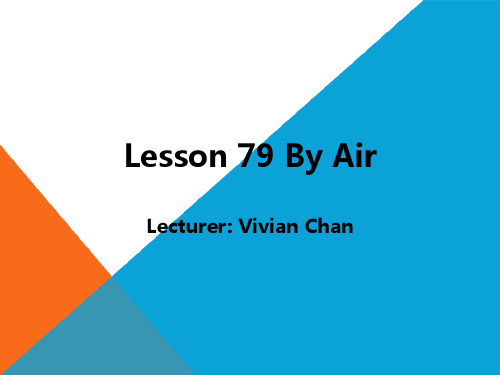
Lesson 79 By Air
Lecturer: Vivian Chan
Check-in desk
Complete these sentences with a suitable word. 1 There was a mechanical problem, and we ended up with a two-hour_______ 2 Several passengers had to fill in landing ______ 3 I went through passport control and sat in the departure ______ 4 If you have nothing to declare, you follow the green sign when you go through _____ 5 A woman at the check-in desk weighed my ______ 6 I look for our flight number on the departures ______
Global Reading
While we were waiting to land, a flight attendant told us to keep calm and to get off the plane quietly as soon as it had touched down. Everybody on board was worried and we were curious to find out what had happened. Later we learnt that there was a very important person on board. The police had been told that a bomb had been planted on the plane. After we had landed, the plane was searched thoroughly. Fortunately, nothing was found and five hours later we were able to take off again.
- 1、下载文档前请自行甄别文档内容的完整性,平台不提供额外的编辑、内容补充、找答案等附加服务。
- 2、"仅部分预览"的文档,不可在线预览部分如存在完整性等问题,可反馈申请退款(可完整预览的文档不适用该条件!)。
- 3、如文档侵犯您的权益,请联系客服反馈,我们会尽快为您处理(人工客服工作时间:9:00-18:30)。
新概念英语第二册语法知识点:倒装句
一、倒装的类型
1.完全倒装:整个谓语移至主语之前。
Out rushed the students to welcome the foreign friends.
2.部分倒装:只把系动词,情态动词,助动词或表语放在主语之前。
Seldom does he go to school late.
二、倒装结构的基本用法
1、因为语法结构的需要而使用的倒装
1) 疑问句中,用完全或部分倒装,但以疑问词或疑问词修饰的
名词作主语的疑问句要用正常语序
Where did he go last Monday?
Are you listening to the radio?
2) “there be”结构中,There are three wells in our village.
There stands a big paper making factory by the river.
3) 在以here, there, now, then, in, away, up down等副词
开头的句子中,使用完全倒装结构。
但如果主语是代词则用正常语序。
There goes the bell.
Now comes your turn to play
Down she went.
4) 在以neither nor 或no more开头的句子中,表示“……也不这样”, neither和nor意思相同,能够替换使用;no more表示动作的水准并不比前面提到的稍强,意为“也不……”。
I can’t swim, nor (neither) can she .
He hasn’t been to the countryside, neither does he want to go there.
He did not turn up. No more did his wife.
5) 用在as(即使)引导的让步状语从句中,从属连句as用于特殊语序,含义与though, although相同,但“as”这种结构可表示非常强烈的对照,必须用倒装(表语提前)。
Proud as the nobles are, he is afraid to see me .
Young as he is, he knows a lot .
2、为了增强语气而使用的倒装。
(使句子更加流畅,更加生动)
1) 含有否定意义的副词或连词放在句首时,常用否定词有:never, not, hardly, scarcely, seldom, little, not until, not only…but also, no sooner …than, hardly (scarcely)…when等。
一般主句用部分倒装结构。
Never before have we seen such a sight.
Little did I think that he could be back alive.
Not until New Year’s Day shall I give you a gift.
Not only was everything that he had taken away from him, but also his German citizenship.
2) 副词only放在句首时,only 起强调作用,其句型为“only +状语+部分倒装”。
如置于句首的only修饰主语,则不用倒装结构。
Only then did he realize his mistakes.
Only in this way can you learn maths well.
Only Mother can understand me.
3) 虚拟语气条件从句中,把从句中if省略将were,had或
should放在主语的前面。
Were they here, they would help us.
Had I been informed earlier. I could have done something.
Should you fail, take more pain and try again.
4) 直接引语的全部或一部分放在句首时,主句主语和谓语次序
颠倒,用完全倒装。
但如果主句主语为代词时或谓语部分比主语长,
一般不用倒装。
“He is a clever boy.” said the teacher.
“Go, Dick, go!” cried Tom, “Go home and get help.”
“What do you think of the film?” he asked.
“I’m leaving for Hongkong next month.” Mary told me yesterday.
5) 表示祝愿的句子中,谓语动词或谓语的一部分放在主语的前面。
May you succeed!
Long live the Communist Party of China.
6) 副词so在句首,表示前面所说的情况也适合于另一个人或另
一事物的肯定句中。
He is interested in pop-songs, and so am I.
They will learn chemistry next term, so will I.。
